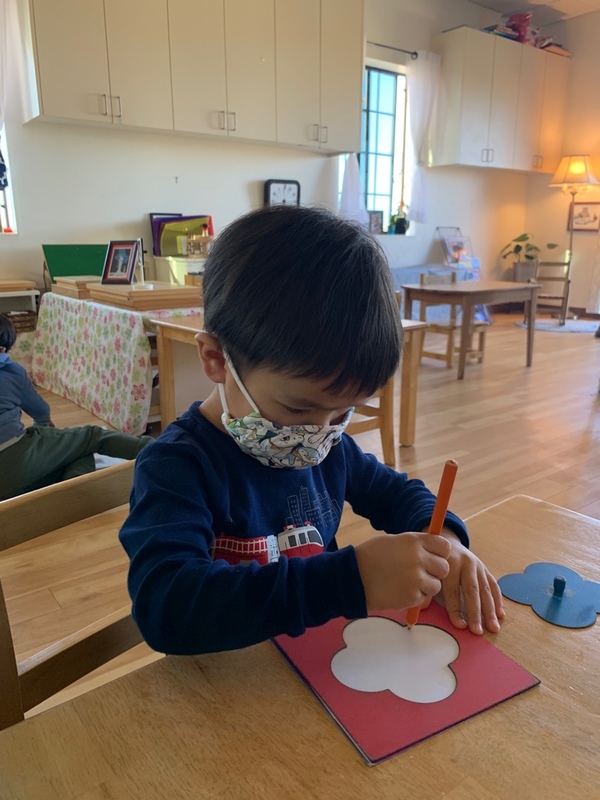(858) 759-0631
I want to discuss the importance of the third year in Montessori. As most of you know, learning in a Montessori environment is individualized. This means your child can work at his or her own pace while participating in a mixed-age classroom community. Younger children benefit from example, and learn from the activities of the older children, while each older child gains the self-confidence that comes with responsibility and leadership. Montessori is a continuum of education that allows your child to build upon his or her experiences each year.
In the first year, your child predominately works around the practical life area. Your child learns how to sweep the floor, polish silver, and clean the leaves of plants as well as experiment with sensorial materials that educate the visual, auditory, and tactile senses. As your child continues into their second year, he or she is introduced to sounds and symbols which lay the groundwork for reading and writing in the future. They are introduced to numbers and the decimal system in a very concrete fashion. They learn about land and water forms, geometric figures, and the political countries of the world. They also learn about the parts of plants and animals, music and art, and science – all at their own pace, in their own time. It is during his third year (the traditional kindergarten year) that everything comes to fruition for your child. Reading, writing, and mathematical understanding moves from the concrete to the abstract and the child leaves the program not only with a strong set of academic skills; but, far more importantly, with the attitude that learning is fun, exciting, and boundless.
What does this mean to you and your child? The third-year is really where everything comes together. When a child transfers from Montessori to a new kindergarten, she spends the first few months adjusting to a new class, a new teacher, and a whole new system with different expectations. This, along with the fact that most public kindergarten programs have a much lower set of expectations for five-year-olds than most Montessori programs, severely cuts into the learning that could occur during this crucial year of their lives. Montessori is an approach to working with children that are carefully based on what we've learned about child development from several decades of research. As a "developmental" approach, Montessori is based on a realistic understanding of children's cognitive, neurological and emotional development. One important difference between what Montessori offers the five-year-old and what is offered by many of today's kindergarten programs has to do with how it helps the young child to learn how to learn. A great deal of research shows that quite often students in traditional programs don't understand most of what they are being taught. Howard Gardner, Harvard Psychologist and author of The Unschooled Mind, suggested that "many schools have fallen into a pattern of giving kids exercises and drills that result in their getting answers on tests that look like understanding."
Montessori is focused on teaching for understanding. In a primary classroom, three and four-year-olds receive the benefit of two years of sensorial preparation for academic skills by working with the concrete Montessori learning materials. This concrete sensorial experience gradually allows the child to form a mental picture of concepts like "how big is a thousand, how many hundreds make up a thousand, and what is going on when we borrow or carry numbers in mathematical operations. This translates into real understanding during their kindergarten year. In traditional kindergarten programs, children are essentially filling in workbook pages with little understanding. Superficially, it may appear that they have learned a lot, but the reality is most often that what they have learned was not meaningful to the child. A few months down the road, little of what they "learned" will be retained and it will be rare for them to be able to use their knowledge and skills in new situations.
Montessori children are generally doing very well academically by the end of kindergarten, but that is not our only objective. Although our program offers enriched lessons in math, reading, and language, our goal is to ensure that whatever they do, they do well and master. It is important to remember that this normally does not come at a predetermined rate, hence the individualized curriculum. The children leave their kindergarten year having done a good job with their work and feel good about themselves as learners.
Some parents worry that having younger children in the same class as older ones will leave one group or the other short-changed. They fear that the younger children will absorb the teachers’ time and attention, or that the importance of covering the kindergarten curriculum for the five-year-olds will prevent teachers from giving the three- and four-year-olds the emotional support and stimulation that they need. Montessori teachers play a very different role from traditionally trained educators. The Montessori teacher’s role is that of a facilitator and guide. The guide’s role centers around the preparation and organization of appropriate learning materials to meet the needs and interests of each child in the class. The guide closely monitors their students' progress, keeping the level of challenge high. Because we come to know your children so well, we can often use their interests to enrich the curriculum and provide alternate avenues for accomplishment and success. Although I am thrilled to see the academic advancements made by all of my students, my real hope is that they will feel good about themselves, enjoy learning, and will love school.
-Primary Teacher

